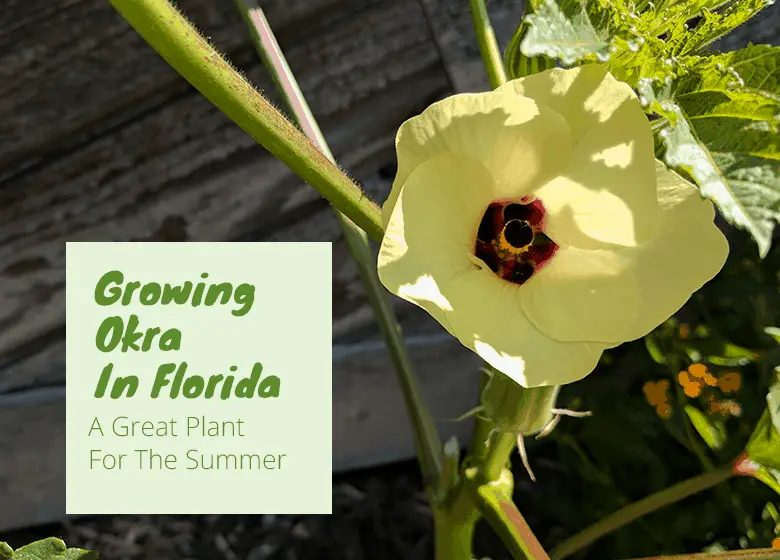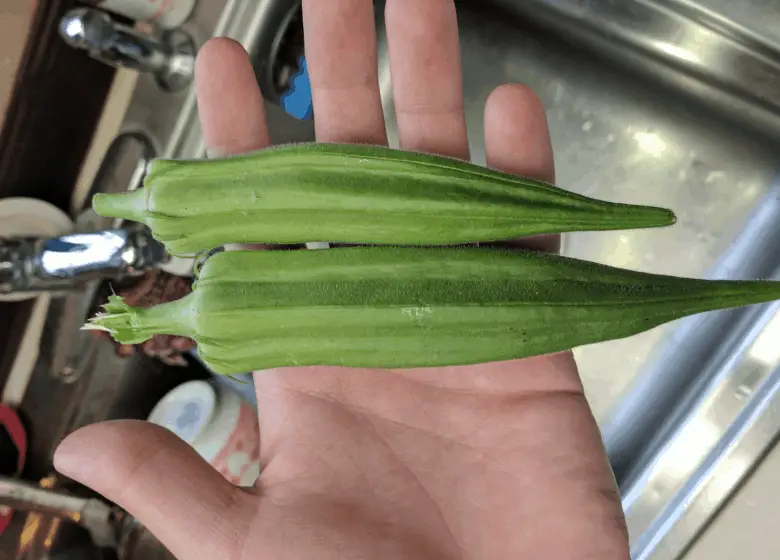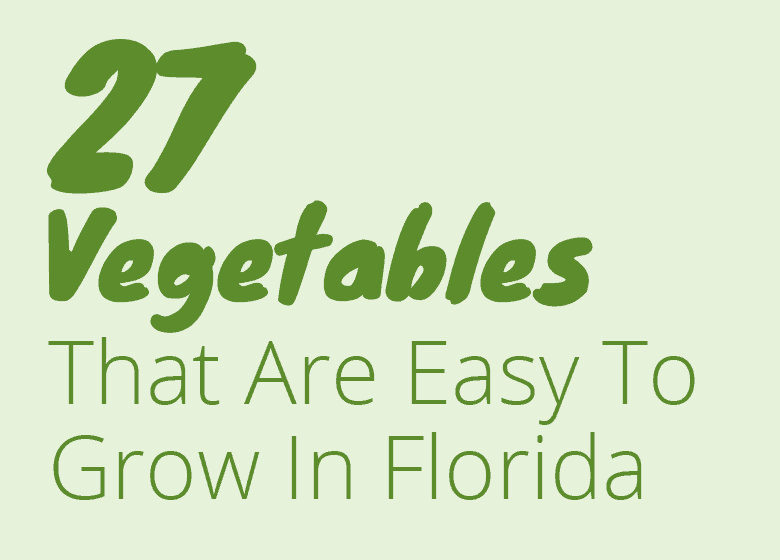
growing okra in Florida couldn’t be easier. Okra is one of the only vegetables that can withstand the Florida summer.
The best variety of okra to grow in Florida is Clemson Spineless. Plant in the mid to late spring, So that the plant can grow during the warmest months of Florida. South Florida can also replant Okra in August to grow through their warm “winters”.
Okra isn’t everybody’s favorite tasting food but even if you don’t like the way it tastes you should still give it a grow in your garden.
It is a beautiful plant, part of the hibiscus family it has really nice looking yellow and purple flowers.

Florida Friendly Okra Varieties
Clemson Spineless isn’t the only variety of okra that you can grow in Florida, there are a few other varieties.
- Alabama Red
- Annie Oakley II
- Baby Bubba
- Cajun Delight
- Clemson Spineless
- Cow Horn
- Emerald
- Little Lucy
I really like the Clemson Spineless variety because it is, as the name suggests, spineless. Some other varieties of okra have little spines on them that make working with the plant difficult.
Harvesting, pruning and pest control become more of a task than a pleasure when your hands are getting poked up.
The varieties Baby Bubba and Little Lucy are dwarf varieties which are perfect for container gardens and smaller spaces.
When To Plant Okra In Florida
Okra loves heat and humidity. This is one of those rare vegetables that you can actually grow during the summer months of Florida.
- North Florida: March – June
- Central Florida: Feb – Aug
- South Florida: Jan – Mar & Aug – Oct
These times are all estimates that are based on averages of the last frost date for your area. Okra does not really like the cooler weather. So, when deciding when to plant okra use your best judgment on when you think cold weather is gone in your area.
In central Florida, where I am, it’s almost a guarantee that we won’t see frost after the end of February. However, some years we may never see a frost so we could actually plant sooner than the recommended time.
Use these dates as a guideline and know that some years will be different than other years.
Planting Okra
Okra needs full sun in order to maximize production. and when i say full sun i actually mean full sun. Okra loves to be beaten down by our blazing summer sun.
I don’t understand how anything can actually enjoy our summer sun, I can’t even enjoy a stroll through the parking lot during our summer months without complaining about sweating.
But okra does it. pick the sunniest part of your yard and I bet okra will thrive for you.
The only caveat to that would be if the sunniest part of your uard had soggy soil. Okra does not like to have it’s roots wet for an extended period of time.
Okra does like plenty of water but it needs to be in a soil that drains well. If you are planning on planting directly into your soil make sure that you add compost and a nice thick layer of mulch at the very least.
I have raised bed built and I like to build my soil. I have always found good luck with a mix that looks like this:
- 40% Coco Coir (Check price on Amazon)
- 40% Compost (You can get it on Amazon but I’ve found it way cheaper at local stores)
- 20% perlite (Check price on Amazon)
- Worm castings (Check price on Amazon)
- Mykos (Check price on Amazon)
You can substitute peat moss for coco coir because it is easily found at your local hardware store, although not as environmentally friendly. Compost and perlite are also readily available at most local nurseries.
Worm castings and Mykos are optional ingredients, but I have noticed a difference when I use them.
When planting okra from seed it might be a good idea to soak your seeds overnight. Many resources online say that that will help your germination rate. I’ve planted my seeds directly into the soil before and gotten good results as well though.
Caring For Okra
Okra is a relatively carefree plant. besides making sure that you water them everyday. Okra enjoys frequent watering but it will not tolerate wet feet for an extended length of time.
Ensure that your plant is in well draining soil.
Okra is susceptible to root-knot nematodes. These are microscopic things that live in the soil and damage the roots of your plant. Florida soil is known to have a nematode problem so this is probably going to be the biggest challenge that you face when growing okra.
There are temporary fixes by adding certain things to your soil but these will eventually wash out. You can either plant in a container or raised bed to make sure that nematodes don’t get to your plant.
or you can try planting things that repel nematodes.
Marigolds are a really good plant to grow in Florida that is said to repel nematodes. For more on growing marigolds in Florida check this out.
Fertilizing Okra
Okra enjoys fertilizer similar to most fruit producing vegetables like the tomato or eggplant. I would recommend something like Tomato tone(Check price on Amazon). Its a balanced 3-4-6 fertilizer with added calcium and sulfur.
The three values, nitrogen(N), Phosphorous(P), and Potassium(K) all help the plant do something different. Nitrogen helps the plant produce green leafy growth, phosphorous helps the plant produce more flowers, so therefore more fruit. And potassium is a general health booster.
Fertilizing okra is different than fertilizing collards. With collards, your main harvest would be the leaves so you would want a nitrogen focused fertilizer. With okra, our main focus is the fruit so our fertilizer should be higher in phosphorous than nitrogen.
Although it’s worth noting that Florida’s soil is naturally high in phosphorous, so if you are planting directly into your yard it’s a good idea to get your soil tested.
Take a sample to your local extension office, it’s less than 5 bucks to get it analyzed.
To find your local extension office click here.
Harvesting Okra
Okra should be harvested when the pods are no bigger than 3 inches. If the okra pods start to grow larger than that they become almost inedible. They get very tough and stringy.
When harvesting okra you should stay aggressive with it, harvesting almost every day. You can pick the pods when they are only an inch or so long. Also, the more you pick the more the plant produces.

You can store okra in the fridge for about a week.
If you didn’t plant the Clemson spineless variety you will want to wear gloves when harvesting. The plant and fruit have tiny little spines on them that can irritate your hands.
Growing Okra
- Okra grows well in the Florida heat
- Plant in mid to late spring in all parts of Florida. South Florida can plant again in Fall.
- It can take our intense summers as long as it receives plenty of water
- I prefer the Clemson spineless variety because it doesn’t have spines that irritate the skin.
- Plant in full sun and well-drained soil
- Fertilize with a well-rounded fertilizer
- Harvest your okra often, before pods grow over 3 inches long
You Might Also Be Interested In:


